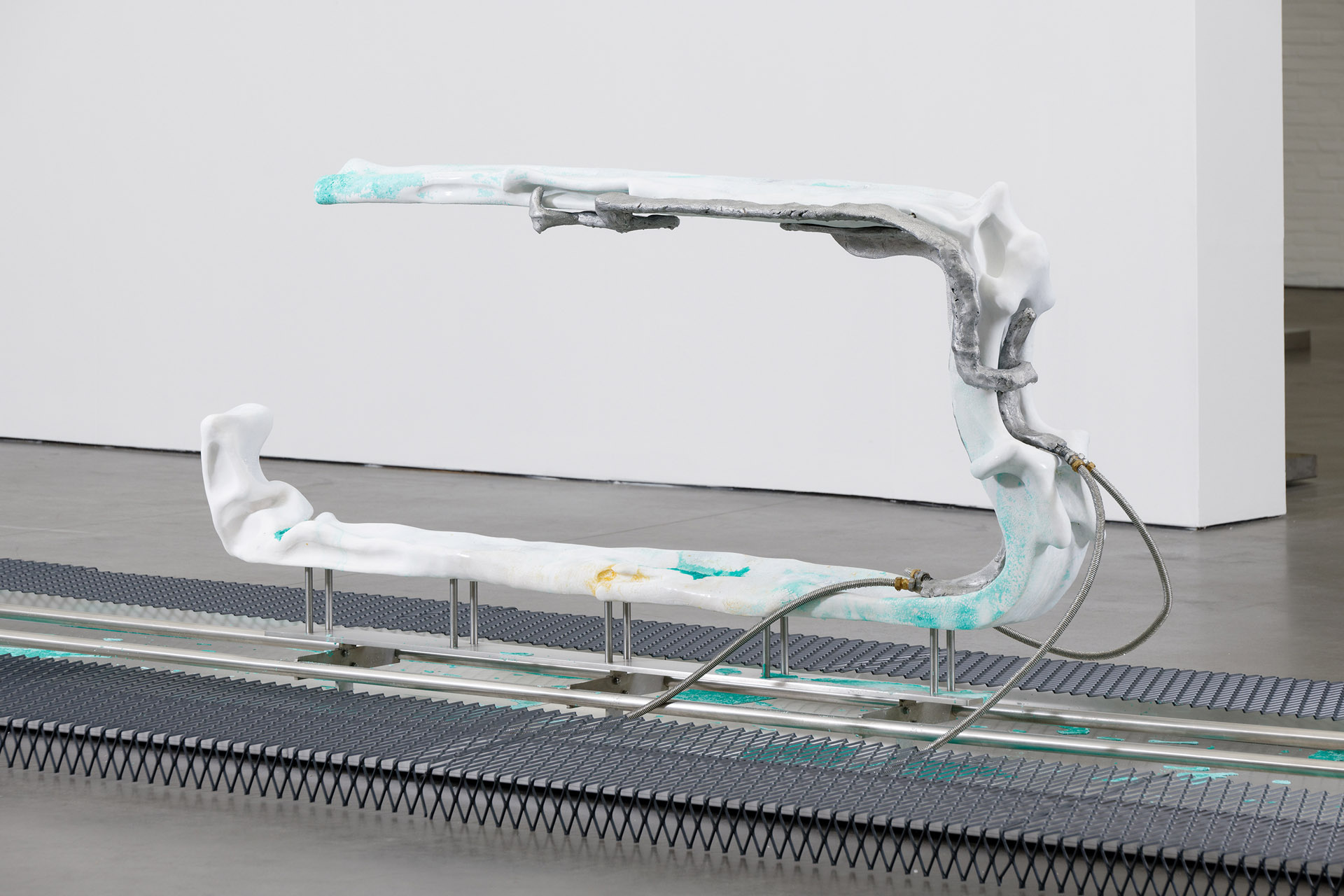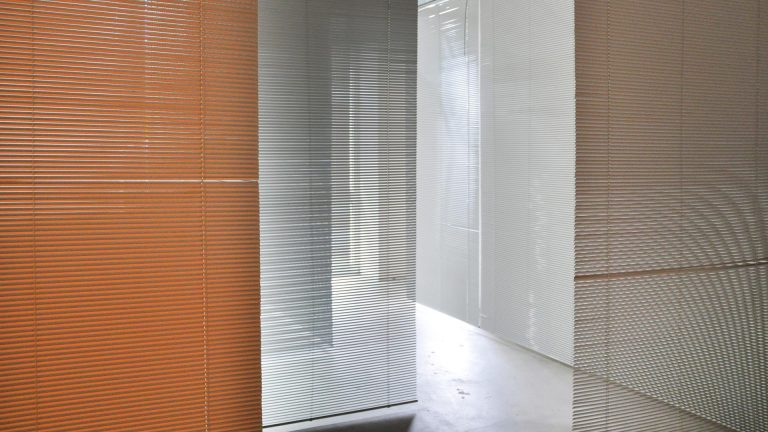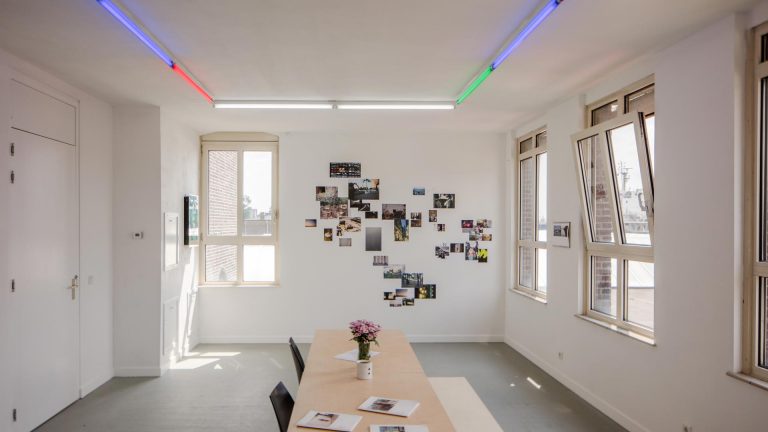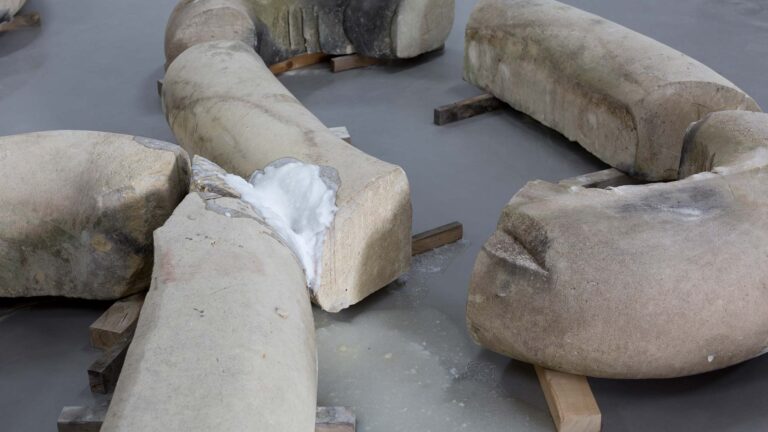Artist: Isabelle Andriessen
Exhibition title: Dorm
Venue: De Pont Museum, Tilburg, The Netherlands
Date: September 18, 2021 – January 23, 2022
Photography: all images copyright and courtesy of the artist and De Pont Museum
Matter may be living, nonliving, or dead – you might expect the distinctions to be explained in an elementary biology lesson. But are those distinctions really as clear-cut as they may seem? Dutch artist Isabelle Andriessen (1986) explores in her sculptures the gray area between them. Her sculptures contain elements that react to each other and their surroundings, so that her works are constantly in motion. Using electricity, cooling systems and chemical processes she causes her sculptures to ‘sweat’, leak, and crystallize, as though they were actors performing from a script. The surfaces may melt; they may sprout bilious green or sulphur-yellow crystals; sometimes dripping stones resembling stalactites appear over time, changing the shape in the course of the exhibition. This enables the sculptures to display autonomous behavior, over which the viewer – and even the artist – gradually loses control. Especially for DORM, Andriessen developed new sculptures in which organic shapes fuse with elementary and architectural forms. They refer both to the original function of De Pont – a former wool mill – and to a grim future.
From the start Andriessen has had a unique vision of sculpture. Driven by the question as to what happens with the materials left behind by mankind, she imagines a future in which synthetic materials have their own agency or mingle with living materials. Do we still have control over them then? What if those materials in fact turn against us? Her works derive inspiration from both science and science fiction. She hints at a world in which microplastics are already imperceptibly creeping their way into our bodies. In this way the suggestions in her works are more plausible and realistic than one might realize. The sculptures can be read as ruins, as future fossils, or as activated materials evolving and enduring an environment under severe pressure.
Their intriguing forms often look familiar while at the same time evoking an eerie sensation. When it becomes apparent that the work is – barely perceptibly – in motion, we realize that she has activated the materials of her sculpture, so that they are continuing the creative process. A seemingly unchanging object, above which we as viewers are elevated, transforms itself over time. This happens throughout the exhibition – indeed several exhibitions – although in an agonizingly slow process. As viewers we witness that process, but paradoxically, it is only much later that the result becomes visible.
Andriessen’s sculptures are like time machines that show and intensify the passage of time, but also force us to embrace decay. With the works in DORM – the title refers to a room but also to something that is sleeping and may awaken at any moment – Andriessen seeks to give materials a certain viability. She enables her sculptures to act as performers by tapping them into a closed system, causing the materials to be activated throughout the exhibition. Standing backstage, as it were, are the generators, compressed air installations and cooling equipment: the source that keeps these processes going.
Even within the works – made of ceramic material, aluminum and epoxy – Andriessen takes another step. She mixes organic forms with references to industry and architecture, partly inspired by the machines that once stood in the former wool mill. Three black rubbery frames suggest some sort of car engine, while their detailed contours are reminiscent of prehistoric remains. Another series consists of open structures covered in a waxy yellow glaze, evoking the uncanny – seductive and repulsive at the same time. These could be drains, or parts of sewers; they involve whimsical, lobed forms, and it isn’t clear whether these forms are emerging from the structures or taking hold of them. In this way, Andriessen seems to be seeking new anatomies.
Andriessen seeks to emphasize invisible networks in which identity, including the identity of the materials, becomes a fluid concept and in which human beings are merely cogs in the system. Based on that vision, everything is eventually set in motion. She seems to be saying: ‘everything coalesces, everything is transformed’.
In the exhibition, when the sculptures are filled with chemicals and tapped into the various systems, the materials become increasingly dependent on each other and on the surroundings. The sculptures will ‘sweat’ and drip, and slowly (very slowly) crystals will form onto the porous surface. That continuous transformation is at odds with the museum’s task of conservation. After all, is it actually possible to preserve a sculpture that keeps on developing? And can that development be predicted? Another interesting aspect: does that change influence the economic value of the sculpture? These controversial questions enable us to view her oeuvre as an alternative to, or criticism of, the museum collection Andriessen desires to control and choreograph time, in whatever form that may take. Ideally then, she would like to incorporate even more interconnected processes and use even more materials whose various timetables influence each other permanently. Ultimately, she is striving for a work that is literally a pièce de resistance, a work that offers resistance to the finite, while at the same time failing in its viability. A work as one big vanitas image, with which Andriessen seems to want to expand the notion of decline.
The works in this exhibition have been made possible in part through the support of Mondriaan Fund, Amsterdam Fund for the Arts and Niemeijer Fund.
Isabelle Andriessen (Haarlem, 1986) lives and works in Amsterdam. She studied at the Rietveld Academie and Malmö Arts Academy. After that she was a resident at the Rijksakademie in Amsterdam (2017-2018). Her work has been shown in group exhibitions at the Stedelijk Museum, Amsterdam, the Lyon Biennale, Lafayette Anticipations, Paris, Warsaw Museum of Modern Art, and Lustwarande, Tilburg. In
2020 she was nominated for the Volkskrant Visual Art Prize. Later this year she has her first solo exhibition in Switzerland at CAN Center d’Art Neuchâtel. Later this year her work will be shown at FRONT International, Cleveland; Palace Enterprise, Copenhagen and GAMeC, Bergamo.
Isabelle Andriessen, Bunk Beaks, 2021, ceramics, aluminium, epoxy, stainless steel, iron II sulphate, water cooler, pump, Photo credit: Peter Cox
Isabelle Andriessen, Bunk Beaks, 2021, ceramics, aluminium, epoxy, stainless steel, iron II sulphate, water cooler, pump, Photo credit: Aurélien Mole
Isabelle Andriessen, Bunk Beaks, detail, 2021, ceramics, aluminium, epoxy, stainless steel, iron II sulphate, water cooler, pump, Photo credit: Aurélien Mole
Isabelle Andriessen, Bunk Beaks, detail, 2021, ceramics, aluminium, epoxy, stainless steel, iron II sulphate, water cooler, pump, Photo credit: Aurélien Mole
Isabelle Andriessen, installation view DORM, 2021, Photo credit: Peter Cox
Isabelle Andriessen, Necrotic Core, 2021, ceramics, aluminium, epoxy, stainless steel, nickel sulphate, water cooler, pump, Photo credit: Peter Cox
Isabelle Andriessen, Necrotic Core, detail, 2021, ceramics, aluminium, epoxy, stainless steel, nickel sulphate, water cooler, pump, Photo credit: Aurélien Mole
Isabelle Andriessen, Necrotic Core, detail, 2021, ceramics, aluminium, epoxy, stainless steel, nickel sulphate, water cooler, pump, Photo credit: Aurélien Mole
Isabelle Andriessen, Necrotic Core, detail, 2021, ceramics, aluminium, epoxy, stainless steel, nickel sulphate, water cooler, pump, Photo credit: Aurélien Mole
Isabelle Andriessen, Crypt, 2021, ceramics, aluminium, epoxy, stainless steel, water cooler, pump, Photo credit: Peter Cox
Isabelle Andriessen, Crypt, detail, 2021, ceramics, aluminium, epoxy, stainless steel, water cooler, pump, Photo credit: Aurélien Mole
Isabelle Andriessen, Crypt, detail, 2021, ceramics, aluminium, epoxy, stainless steel, water cooler, pump, Photo credit: Aurélien Mole


















